Leather care, preservation, conservation, oiling leather, leather finishes
This material may not be used without written permission. You may link to this page.
Preservation
of
Original Leather Items
For vegetable Tanned leather
This page is under construction so check back for updates
This is a large page and is slow to load please be patient
This Page has been updated on 09/08/09
This is a very brief discussion of the damage that can be caused by the loss of moisture in vegetable tanned leather.
If you have any question please contact me. I may be able to communicate a little better verbally.
Leather Tanned Prior to 1890
Today leather is sold by square foot but until the mid 1880’s leather was sold by weight. Due to the fact that higher weight brought a higher price, tanners used every means available to increase weight. One of the most inexpensive ways to increase weight was to impart high quantities of tannins. This overuse of tannin can cause brittleness and cracking of the grain surface so more oils were needed to offset the additional tannins. Many original examples are now showing the damage that the overuse of the tannin and oils have caused.
After the leather was tanned a protective finish was applied to protect the leather surface which was required by the Ordnance Department. This finish contained waxes and oils which sealed the grain surface and prevented the oil from oxidation. As long as the finish remained on the surface the oils were held in to keep the grain surface lubricated and it remained soft and pliable. As the leather aged the finish was worn away and the oils were allowed to oxidize and penetrate into the fibers. This left the grain surface unprotected and it would dry out and would begin to crack and flake. The Ordnance Dept was apparently aware of this as there is record of the acquisition of polishes.
Aging Theory: I have discussed this condition with several tanners and we have come to this theory: We believe that as the finish wears away and the oils are allowed to oxidize using the available moisture in the grain surface; which makes the surface dry out and begin to cup. This cupping process is caused by the grain drying out faster than the fibers underneath. As the grain surface shrinks it will eventually tear itself loose or flake off. (A good mental picture: the ground when the surface has dried rapidly and begins to crack and cup)
The flaking and cracking of the drying out process is sometimes diagnosed as “acid rot”, a condition caused by acids actually decaying the leather rather than a drying process. The two appear very similar.
A good wax will protect the moisture in the grain stopping this cracking and flaking process caused by lack of moisture
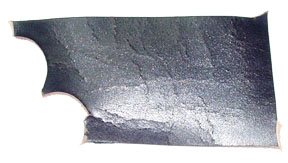
Surface Cracks
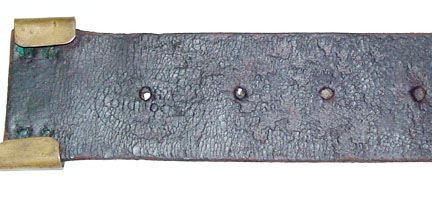
Surface Flaking
The information below will help you understand the aging process of leather.
The first thing to remember is that leather is skin (from a cow, horse, pig, or goat and etc.) that has undergone a tanning process to make it "decay resistant" along with imparting qualities of strength, flexibility and overall appearance. This was done by the tanner to give a certain number of years of good use from that piece of leather. What makes a leather item last longer than another is the care and feeding that it was given by its owner. This care and feeding is very important. For years the debate has raged about which product to use to treat leather. Some say do nothing and others say to oil the leather at least once a year. So what is the best thing to do?
Moisture: This is the most important point in leather care. All changes in leather are due to moisture differences. If too much moisture is lost leather becomes very hard and brittle. Water is the best lubricant; but it can be lost so some oil must be used in order to maintain a soft supple grain surface. When the leather was originally tanned the tanners oiled (cod) as a medium-term lube and (tallow) as a long term lube. Moisture can play another role if the climate is moist then mold can form on the leather surface. (see information on mold below)
Oils: Catch 22. It seems logical to lubricate the leather with oil to make it soft when in fact adding oil can cause damage. Oil is necessary in leather. Oil acts as a lubricator in the leather fibers. The oil in the fibers allows them to side over each other without causing damage to the fibers. The problem is when too much oil is used this stops the leather from being able to breathe. As humidity goes up and the leather adsorbs moisture if too much oil has been used the excess moisture will not be allowed to escape and this will start the leather to rot. Remember when it comes to leather a little oil is good but a lot is very bad. Oil used in a large quantity weakens the tensile strength of the leather fibers. This can occur with as little as 21% oil content in the leather. Leather coming from the tannery has an oil content of only 16 to 19%. The best guess I have is to keep the oil content under 30% overall.
Oxidation: How oil penetrates is through oxidation. All oils will oxidize over time. It just depends on the type of oil and conditions to how long this process takes. See Notes at the bottom of the page.
Oil softens the leather by changing the shape and placement of the fibers. Oil penetrates the fibers causing them to distend and swell. Some of the fibers will move out of the tightly packed order into a looser order. This is what makes the leather soft. These physical changes in the leather cause it to become weaker and weaker. This process is irreparable. I have seen this in shoes that have been oiled to the extent that the leather began to crack and tear. Over oiling is one of the worst things you can do to leather. Remember, a little oil goes a long way.
Please do not use any oils that contain mineral oils or listed as petroleum distillates. This type of oil over time breaks down into a solvent, and since solvent can de-tan, you get double damage. If you must oil, use natural oil like "pure Neatsfoot" or a good grade of tallow. Please read the labels of any thing you apply to leather very carefully.
How do you protect your leather: The grain surface takes the most damage from the loss of moisture. The best way to protect it is to maintain a polish on the surface that will seal and protect the moisture in the leather fibers from drying. Specially formulated wax finish would be the best. There is a polish that uses a natural ingredient that helps stop the growth of mold and mildew even in damp environments. This ingredient also helps stop insect damage as well. This was known and used during the 1800's in a leather called "Russia leather". The problem is the knowledge was lost by the end of the 1800's. The product is known as Preservation Wax. You should apply the wax at least twice a year, and maybe more if the items are used heavily. When at least 50% of the original finish is present I would recommend the clear wax. When applying the finish on leather that is beginning to flake or crack there may be some flakes that come off during the application of the wax.
The lamp black in the black wax may rub off so for the best protection a coat of clear wax should be applied over the black wax. Multiple coats may be applied with a waiting period of one day between coats.
Leather does require oil but most do not know how to oil, and this is very important.
The following passage from a publication called Privates’ Manual, by Major Jas A. Moss printed in 1915. This passage gives a look into the knowledge that was known by the average person and was written down in a time when this knowledge was starting to be lost, but since the army still depended on leather in its accouterments a knowledge that was required.
“Cleaning. Daily, or as often as used, leather equipment should be wiped off with a cloth slightly dampened in water, merely to remove mud, dust or other foreign substances.
At intervals of from one to four weeks, depending upon the circumstances, it is essential that the equipment be thoroughly cleaned in accordance with the following instructions.
(a) Separate all parts, unbuckle straps, remove all buckles, loops, etc., where possible.
(b) Wipe off all surface dust and mud with a damp (not wet) sponge. After rinsing out the sponge, a lather is made by moistening the sponge in clear water, squeezing it out until nearly dry, and rubbing it vigorously upon the soap. When a thick, creamy lather is obtained, thoroughly clean each piece without neglecting any portion. Each strap should be drawn its length through the lathered sponge.
(c) After the leather has been allowed to become partially dry, it should be rubbed vigorously with a soft cloth to give it the neat, healthy appearance that is desired.
How to apply oil. The quantity of oil to be used can not be definitely prescribed. If not enough oil is used, the leather will be stiff and brittle; if too much is used, it will soil the clothing and accumulate dirt. The leather should, therefore, be saturated with sufficient oil to be soft and pliable without excess sufficient to cause it to exude. In applying the oil the following general instructions should govern:
(a) The oil should be applied to the flesh side of the equipment where practicable when the leather is clean and still damp after washing (about half dry), because it penetrates more uniformly when applied from the flesh side, and when the leather is damp. If the leather is dry it will absorb the oil like blotting paper, preventing proper distribution.
(b) The oil should be applied with an oiled rag or cotton waste by long, light, quick strokes---light strokes, so the pressure applied may not squeeze out an excess of oil; quick storks, so that the leather may not absorb an undue amount of oil. The endeavor should be to obtain a light even distribution.
(c) After applying the oil the leather equipment should be allowed to stand for 24 hours, if practicable, in a warm dry place. It should then be rubbed with a dry cloth to remove any unabsorbed oil.”[i]
This is the same way a tannery oils during the currying process and the water helps the oil penetrate the leather fibers. Oiling when dry just makes the oil fill the spaces between the fibers and does not really lubricate the fibers.
The water also keeps you from over oiling which can do as much damage as under oiling. The oil itself works on the fibers by changing the shape and the way they are backed in the leather itself. When the oil penetrates the fibers makes the fiber plump and ever so slightly grow in length. The plumping action causes the fibers to become less tightly packed and this loosening of the fibers themselves causes the leather to become softer. By over oiling this loosening of the fibers cause the leather to loose tinsel strength and makes it weaker and weaker. On the other hand if there is not enough oil to lubricate the fiber it will causes to become brittle and break or tear. So there is a fine line between on enough and too much and this is where the moisture comes in allowing you to oil enough without getting too much.
While we are looking at oil and oiling there is one other myth that I want to dispel, and that is the one that neat’s-foot oil rots the thread. This has been around for many years, but there is no truth in this one but the explanation this a little complicated. The problem that rot thread is not the oil itself but the moisture trapped in the leather by the over use of oil. I know this sounds strange but the fact is leather takes up and looses moisture all the time and this action is fine but as you add oil leather begins to loose its ability to take up and loose moisture until it gets so much oil that the moisture is just trapped. The moisture is what rots the thread but on the other hand if less oil had been used none of this would have happened. This problem is not just neat’s-foot oil but with any oil, the facts are the same. Just follow the instructions above about oiling and this problem will not happen. Oil does not make leather waterproof that is achieved with either the finish applied to the leather at the tannery or by applying a wax based product to seal up the surface.
Remember the grain is the smooth side of the leather. If you use a saddle soap, use very little water. Use a damp sponge, not a wet one. By applying the oil to the damp leather you will not over oil the leather but instead it will get exactly what is needed.
R Remember that in leather a little is good and a lot is bad.
One other thing to remember when doing any leather care on old leather is always test in a small area first since you do not know what someone has done before you. Here is a picture of any original sling that had some work in the past and we he tried to clean the sling it reacted chemically and damage the leather as can be seen in the picture below.
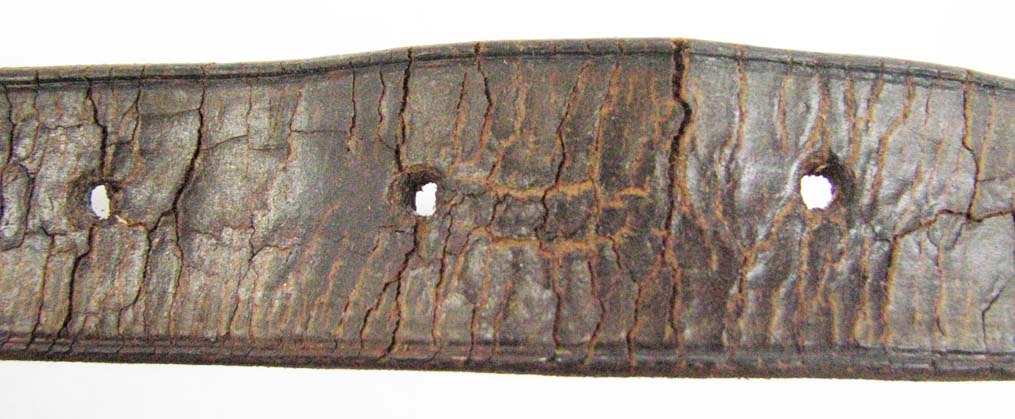
Never store your leather items wet or damp in a sealed or semi sealed container.
With all that said now I have some before and after pictures of some items that I recently worked on for a friend and used the crown soap and neat’s-foot oil and as you can see from the pictures the change was dramatic. With just a little care your leather items should last a long time.
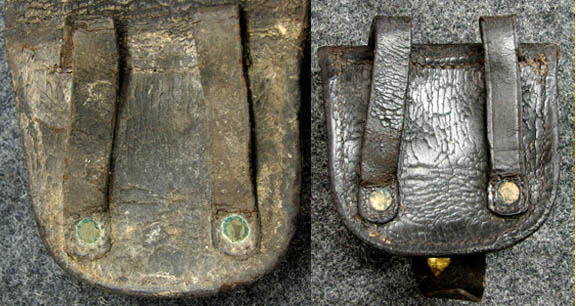
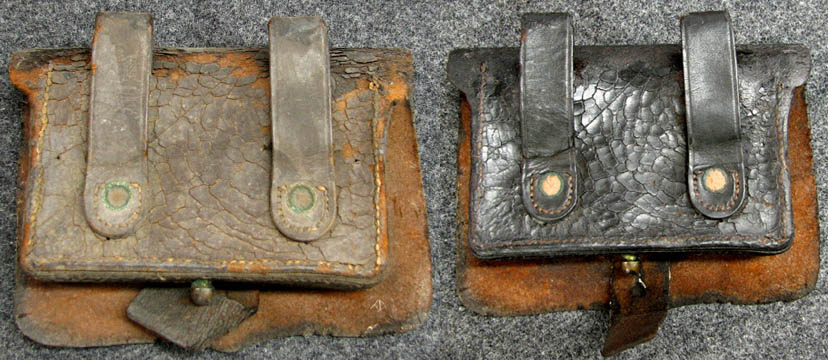
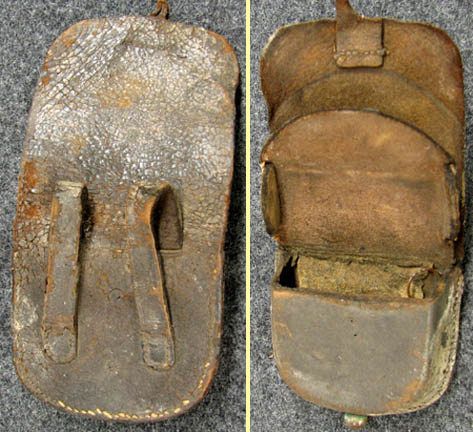
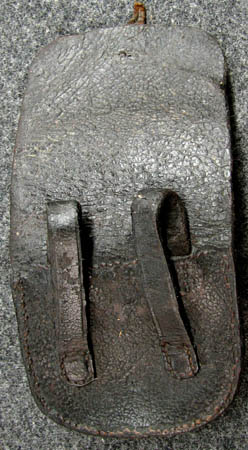

For more information on Vegetable tanned leather please follow this link.
The information on how oils oxidize comes from two different leather chemists.
Henry R. Proctor in describing the process of hot stuffing states how the oil was in the leather and not in the fibers. “The leather is now impregnated with grease, but is far from being properly stuffed. Instead of the grease being spread over the finest fibers in a minute state of division, it simply fills the spaces between the larger fibers.”[i]
John Arthur Wilson states in his book “The vegetable tanning materials causes an oxidation of the unsaturated fatty acids, as indicated by the formation of oxidized acids and the simultaneous disappearance of water from the leather, water presumably being essential to the reaction.”[ii]
The other source of information came from studying the only true oil tanned leather. In the tanning process it was found that the oil did just what was described. The effect on the fiber was to make it grow larger and longer; but at the same time, the fibers became softer and weaker.
For information on oil causing the reduction of tensile strength in leather I would suggest looking in Wilson’s book same page as above.
[i] Henry R Proctor, Text Book of Tanning (New York: E. & F. N. Spon, 1885) page 201
[ii] John Arthur Wilson The Chemistry of Leather Manufacture (New York: The Chemical Catalog Company, Inc., 1923) page 324
[i] Major Jas. A. Moss, Privates’ Manual (George Banta Publishing Company, Menasha, Wis., 1915) pg.54-57.
Tips to help keep your leather item in the best shape possible
Store your leather items wrapped in an acid free tissue paper. This will help slow down the oil oxidation process.
If possible keep all leather items away from UV light. If in display cases try using a film that shields UV or lights that have covers to reduce UV.
Keep the humidity around 50%. Do not let the humidity go above 70%. Leather will mold at 70% humidity and above. Storage of leather in conditions where the humidity is below 30% will dry out the leather over time. Cities like Denver and Phoenix are not kind to leather due to low humidity.
Mold will not have defined edges. Mold spots will have fuzzy edges and will spider out. To remove mold use a small amount of white vinegar on a rag and wipe the surface and allow to dry.

Mold on leather has a circular shape.
Fatty Acid Spew
"Sometimes when finished leathers are chilled, the surface becomes coated with a white crystalline deposit resembling a thin film of snow. This deposit, known to the trade as spew, usually consists of saturated fatty acids having a high melting point."[ii]
Please do not confuse mold with a white oily feeling residue sometimes found on leather. This is called "Spew". Spew is when there is a temperature drop and the amount of oil the leather can hold changes and part of the oil return to the surface of the leather. When the leather warms up the oils will return back into the leather. This is commonly found on leather treated with oil containing "petroleum distillates". The petroleum distillates seem to displace the natural oil and they return to the surface.
English leather is known to spew at low temperature due to the heavy use of tallow.
The spew may be removed by wiping the area with a clean soft cloth.
Here is a picture of what spew looks like.

Soap
Crown soap- 8oz of soap in a tin container $8.95
We are now offering this period soap for cleaning leather. This is based off a period recipe for soap liked by harness makers. This is not like modern saddle soaps but instead is mostly made from cod oil. This type of soap will clean the leather but not be harsh enough to damage the leather. Leather items should be cleaned with soap several times a year in order to prevent the build up of dirt and other things that will damage the grain surface.
Oils
Waxed based finishes
#PW124 Preservation Wax $12.95
This is specially designed product to give you maximum life out of your leather items. This is the clear wax, for use on russet items. This wax contains a natural mold and mildew inhibiter, along with protection from insect damage. This is a 4oz container.
#BPW125 Black Preservation Wax $15.95
This is specially designed product to give you maximum life out of your leather items. Lamp black has been added to help maintain the black color of your leather items. This wax contains a natural mold and mildew inhibiter, along with protection from insect damage. This is a 4oz container.
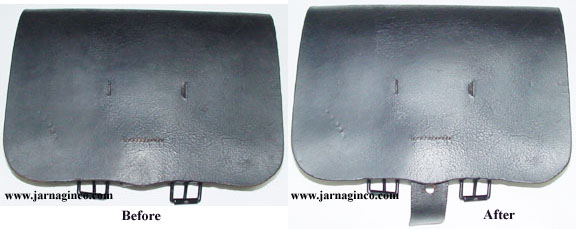
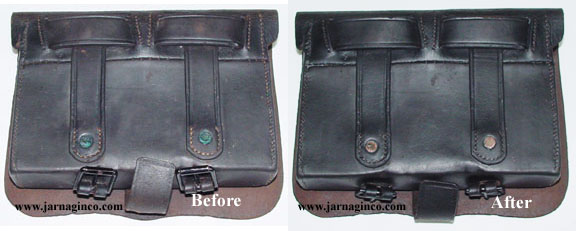
Here are before and after Pictures
Other Link of interest
Leather Therapy is a good company with well researched products and just a great bunch of folks.
Leather Preservation Page for New Leather
C & D Jarnagin Company
On line French & Indian,
Revolutionary Period &
War of
1812
To place an order ...Click
Here!
*Check on the Status of your order
HERE.
Company of Military Historians
Remember that no matter how bad the day is there is always one bright spot and he is Christ 2 Corinthian 12:9&10
And He said unto me, My grace is sufficient for thee: for my strength is made perfect in weakness. Most gladly therefore will I rather glory in my infirmities, that the power of Christ may rest upon me. Therefore I take pleasure in infirmities, in reproaches, in necessities, in persecutions, in distresses for Christ's sake: for when I am weak, then am I strong.